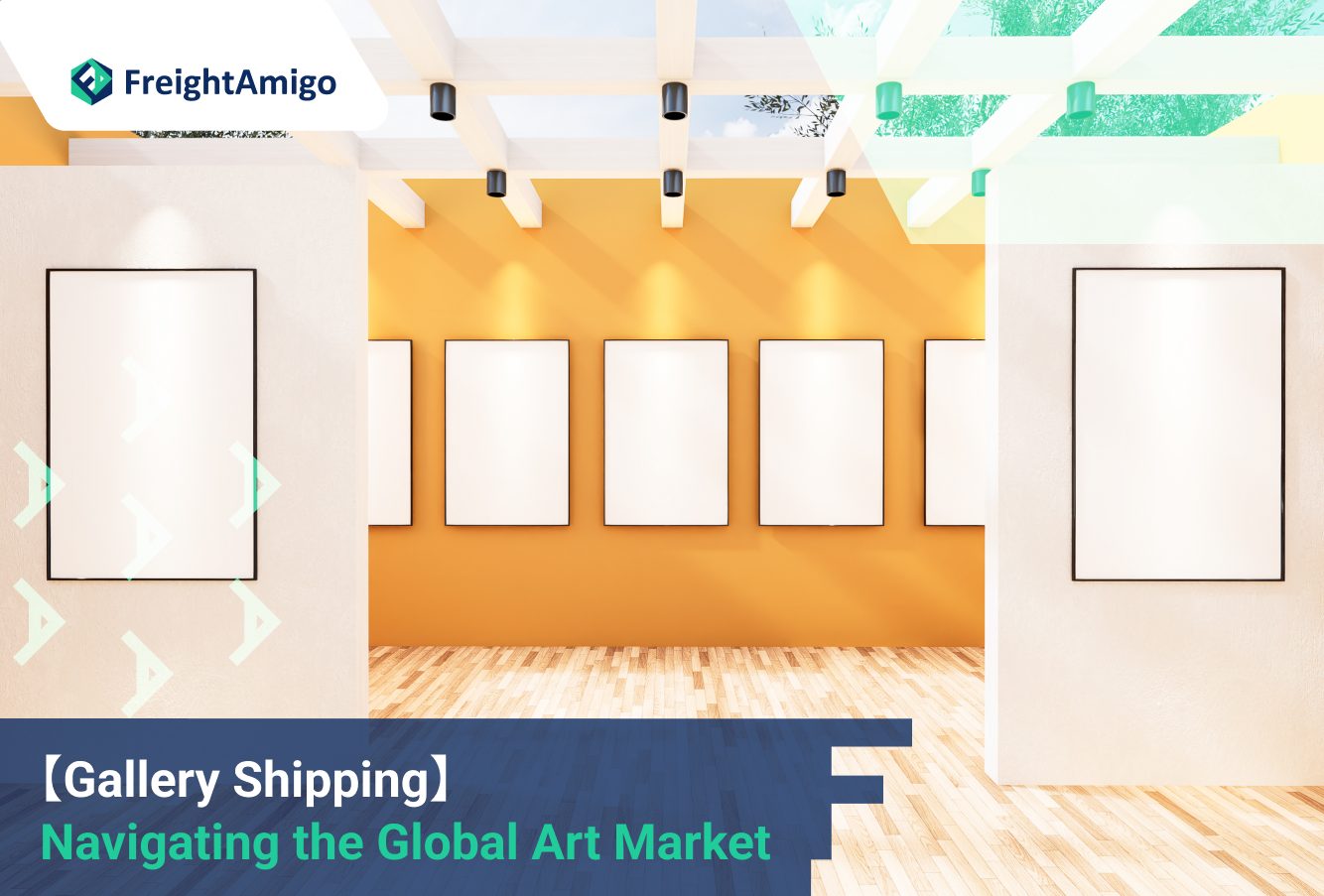Author Name: Tiffany Lee – Marketing Analyst at FreightAmigo
Shipping artwork internationally requires a meticulous approach. It involves taking into account various logistical considerations and challenges. Gallery shipping demands expertise and precision. This comprehensive guide delves into the intricacies of shipping artwork across borders. It highlights key strategies and best practices for a seamless and secure shipping experience.
Want To Compare The Best Express, Air Freight, Sea Freight, Rail Freight & Trucking Rates So As To Have Better Control On Cost?
Introduction to Gallery Shipping
The Global Art Market
The online art market has grown rapidly in recent years, making the art industry a global marketplace. Collectors and sellers can now connect instantly, regardless of their location. Efficient and reliable shipping strategies are essential for the success of galleries due to the increasing popularity of buying art online.
The Importance of Effective Shipping Strategies
Shipping artwork is a nuanced process that requires careful consideration, especially when shipping internationally. Galleries often view shipping practices as a reflection of their overall business services. The shipping process plays a crucial role in ensuring the safe and secure transportation of artwork from the artist’s studio to the collector’s wall. It involves selecting a courier, providing insurance, and handling fragile objects.
Researching and Selecting International Shipping Partners
Factors to Consider
When choosing an international shipping partner, it is important to consider several factors. These include the shipper’s experience in handling high-value and fragile items, the availability of tracking services, and the option for signature-required shipping. It is crucial to research and contact potential shippers to understand their protocols and capabilities to make an informed decision.
Choosing the Right International Shipping Carrier
To ensure your gallery’s shipping needs are met, it’s crucial to select a courier that aligns with your requirements. Established carriers such as FedEx and DHL offer reliable international shipping services for artwork. However, it’s advisable to consider specialized fine art shippers who have expertise in handling delicate and valuable pieces.
Building Relationships with Reliable Shippers
To achieve long-term success for your gallery, it is crucial to build strong relationships with reliable shippers. This can be done by establishing partnerships with trusted shippers, which will ensure consistent and efficient shipping services for your artwork. Regular communication and feedback will help maintain a reliable and seamless shipping process.
Packaging and Crating: Protecting Your Artwork
Customized Packaging Solutions
Properly preparing and packaging artwork is crucial. Each artwork requires customized packaging solutions tailored to its specific requirements. It ensures the safety of the artwork during transit. To provide optimal protection, different materials and techniques should be employed depending on the medium, size, and fragility of the artwork.
Crating Techniques for Different Artwork Types
Various artworks require specific crating techniques to ensure safe transportation. Large and delicate artworks are commonly transported in wooden crates, which provide maximum protection against external impacts. Smaller works are often transported in custom-made boxes and tubes with additional padding.
Insurance and Documentation
To protect your artwork from potential damage or loss during shipping, it is essential to obtain insurance coverage. It is recommended to work with an insurance provider that specializes in fine art coverage to ensure proper valuation and coverage for your valuable pieces. Additionally, prepare accurate and detailed documentation, including condition reports and photographs, to facilitate insurance claims if necessary.
Understanding Customs Regulations and Documentation
Navigating Import and Export Laws
Shipping artwork internationally requires navigating complex customs regulations and import/export laws. Each country has its own set of rules and requirements for importing and exporting artworks, including cultural property restrictions and duty/tax considerations. To ensure compliance and avoid unnecessary delays or penalties, it is crucial to research and understand these regulations.
Required Documentation for International Shipments
For smooth customs clearance, accurate and complete documentation is essential. This documentation includes commercial invoices, packing lists, certificates of authenticity, and any necessary permits or licenses. To ensure that all required documentation is prepared correctly and submitted on time, it is recommended to work with a knowledgeable customs broker or art shipping agent.
Prohibited and Restricted Artwork
When crossing international borders, certain types of artwork may be subject to restrictions or prohibitions. These restrictions can apply to endangered species, cultural artifacts, or artworks with political or religious content. To avoid legal issues and potential confiscation of artwork, it is crucial to research and comply with these restrictions.
Streamlining International Shipping Processes
Utilizing Technology and Automation
Using technology and automation can simplify international shipping. Online platforms and software solutions offer tools for managing inventory, generating shipping labels, and tracking shipments. Automation reduces the chance of human error and increases efficiency, resulting in a smoother shipping experience.
Enhancing Efficiency with Inventory Management Systems
Implementing an inventory management system allows galleries to efficiently track and manage their artwork inventory. These systems provide real-time insights into the location and status of each artwork, streamlining the shipping process. Integrated systems that connect inventory management with shipping labels and tracking further enhance efficiency.
Streamlining Customs Clearance Procedures
Clearing customs is an essential step in international shipping. Streamlining customs clearance procedures can significantly reduce transit times and prevent delays. To ensure accurate documentation and compliance with customs regulations, it is advisable to work with experienced customs brokers or use specialized software solutions.
Ensuring Artwork Safety and Security
Environmental Considerations
Artwork can be affected by environmental factors such as temperature, humidity, and light. To minimize the risk of damage caused by these factors, it is important to handle, package, and transport artwork properly. Additional protection can be provided by using temperature-controlled shipping options and environmentally controlled storage facilities for delicate and sensitive artworks.
Handling Fragile and Valuable Artwork
Fragile and valuable artworks require extra care during shipping. To ensure their safety, we use customized packaging, specialized handling techniques, and secure crating. We collaborate with experienced fine art handlers and shippers who have expertise in handling delicate pieces to mitigate the risk of damage.
Implementing Security Measures
Gallery shipping prioritizes artwork security. To prevent theft and damage, security measures such as GPS tracking, tamper-evident packaging, and secure storage facilities are implemented. It is important to work with shippers that prioritize security and offer comprehensive insurance coverage to provide peace of mind for both galleries and collectors.
Future Trends and Innovations in Gallery Shipping
Advancements in Packaging Materials and Techniques
The art shipping industry is constantly innovating in packaging materials and techniques. Advanced materials, such as shock-absorbing foams and climate-controlled crates, provide enhanced protection for artwork. By exploring and adopting these advancements, the safe transportation of valuable and delicate pieces is ensured.
Shipping Industry Technologies
Technology is essential for improving efficiency and transparency in the shipping industry. Innovations like blockchain, artificial intelligence, and Internet of Things (IoT) devices allow for real-time tracking, secure documentation, and streamlined processes. Embracing these technologies enhances the overall shipping experience for galleries and collectors.
Sustainable and Eco-Friendly Shipping Practices
The art shipping industry is placing more emphasis on sustainability and eco-friendly practices. This is achieved by using recyclable and biodegradable packaging materials, optimizing shipping routes to minimize carbon emissions, and adopting energy-efficient transportation options. By implementing sustainable practices, galleries can demonstrate their commitment to environmental responsibility.
Conclusion
In conclusion, shipping artwork internationally requires a comprehensive understanding of customs regulations, logistics, and best practices. Galleries can navigate the challenges of gallery shipping and provide a seamless experience for collectors worldwide by selecting reliable shipping partners, ensuring proper packaging and documentation, and prioritizing customer service. Staying informed about industry trends and embracing technological advancements ensures that galleries remain at the forefront of the global art market. Gallery shipping can become a catalyst for connecting artists, collectors, and artwork across borders, fostering a vibrant and thriving art community. Careful planning and execution are essential for achieving this.
There Are Different Options For Cargo Transportation. If You Want To Choose The Most Convenient And Suitable Solution, It Is Best To Have The Full Support Of Logistics Experts! If You Are Planning To Ship Goods Overseas, Please Go To The FreightAmigo Page For Inquiries.
===
Read More:
【Cosmetic Product Recycling】 A Guide to Sustainable Reverse Logistics
【Rise of Green Supply Chain】 Pioneering Sustainable Practices in Logistics
【ESG in Logistics】 How ESG Practices Drive Social Responsibility in Logistics
===
If you have any inquiries on logistics/supply chain, feel free to contact FreightAmigo now:
Chat with us online OR
Phone : +852 28121686
WhatsApp: +852 27467829









































